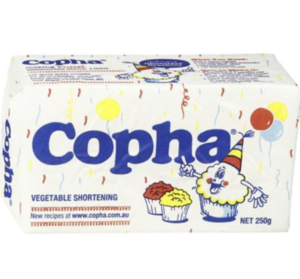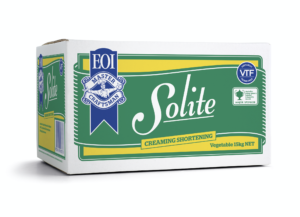Vegetable Shortening - What It is, How to Use It
Have you stumbled across a recipe that calls for vegetable shortening, but have no idea what it is or where to get it from? We will shed some light on it below, as well as add a simple buttercream recipe, that is using Solite vegetable shortening.
What is vegetable shortening?
Vegetable shortening is simply a 100% solid fat. Some other products like butter have water and other solids added to it, shortening has nothing at all. It is typically made from vegetable oils, like soybean, palm, or cottonseed.
Vegetable shortening is a great alternative to butter or margarine for those who are looking to avoid animal products. Shortening is often also used in gluten free bakings. Unlike butter, vegetable shortening has a neutral flavour.
In Australia most popular and commonly used vegetable shortening is Copha. But you may also have heard names Crisco and Solite, when trying to find where to buy some shortening.
Are Copha, Crisco and Solite all the same product?
Even though it might seem so, Copha, Crisco and Solite are not equivalent at all. Whenever the recipe calls for Crisco or Solite, you can usually swap it with Copha, but you can’t always swap it the other way around. So what are the main differences?
What is Copha?
Copha is made in Australia and is widely available in the supermarkets. Copha is made from 99% coconut oil and is the key ingredient in the kids party recipes such as Chocolate Crackles and White Christmas. Copha is hard block of white vegetable fat, that melts to a clear liquid when heated - exactly what you would expect coconut oil to do.

What is Crisco?
Crisco is a brand of shortening manufactured in United States and it is the most common vegetable shortening over there. Crisco is not available in the supermarkets in Australia but you may find it, in some of the well-stocked cake supply stores. The main ingredients in Crisco are soybean oil and palm oil. Crisco can be used in recipes that call for butter or margarine, but is not recommended to use as a spread. Crisco vegetable shortening has soft, creamy texture, and is snow white in colour. I does not set hard like Copha does.

What is Solite?
Solite vegetable shortening is a premium quality creaming shortening, and it is Australian version of Crisco. It has very similar texture and can be used as a direct replacement for any recipes that call for Crisco. Solite vegetable shortening is perfect for buttercreams or fudge icings. It is ideal in Australia’s hot climate when you need your buttercream to remain firm. Like Crisco, Solite vegetable shortening is pure white in colour, which ensures that your colours stay true, unlike when you add them to a buttercream that has the yellow colour of butter. It can be flavoured and coloured using paste colours and powder colours.

Solite vegetable shortening is shelf stable, so it doesn't need refrigerating. This is great cause you can prepare your cupcakes/cakes days in advance. Solite is more widely available then Crisco is. You won’t find it in the supermarkets, but most of the cake supply stores should have it available. If you'd like to give it a go yourself, you can get some from here.
How is vegetable shortening used?
Vegetable shortening is most commonly used in baking and desserts. It is often mixed with butter, because it creates a more luscious taste, without sacrificing the crumblier texture needed in some scones or pie crusts. If you’re swapping out shortening in a cake or bread recipe, the difference in texture will be practically unnoticeable.
Vegetable shortening can be used to make frostings super creamy and white (that won’t melt like butter and margarine) and is also commonly used in pastries, cakes and biscuits. Vegetable shortenings are ideal as a partial or total replacement for butter.
How to Use Vegetable Shortening in Buttercream?
Vanilla buttercream is the traditional choice for bakers and decorators alike. We personally mainly work with ganache and fondant but do make and use buttercream every now and then as well. When we do have to use buttercream, we seem to prefer SMBC over American (only when we know it’s an indoor even, and the buttercream won’t melt off the cake), purely cause of the flavour of it – cause isn’t it all about flavour?
In Australia with the hot and humid weather we have, melting buttercream can be a real problem to have. For that reason, lot of the bakers and decorators prefer to use half (or swap completely) butter half vegetable shortening in their recipes. That will give them much more stable buttercream and less chance that it'll slide off the cake.
The simplest buttercream is mixture of butter (vegetable shortening) and icing sugar, simple. But I’m sure you’ve all heard SMBC, American buttercream, French buttercream, Italian, and so on. And then you’re all confused and not sure which recipe to choose cause they all seems to use, bit different ingredients and have different techniques to make them. So, when did a simple buttercream get so complicated? Let’s discuss it bit further then.
Different Types of Buttercreams
American Buttercream
American buttercream is made simply by creaming together butter or vegetable shortening and icing sugar with little bit of milk, cream or water. Vanilla can also be added for some extra flavouring. American buttercream is typically made from a ratio of 2:1 sugar to butter by weight. Due to that ratio American buttercream is also the sweetest out of all the buttercream recipes.
American buttercream is the easiest buttercream to make and the one most commonly used in non-professional kitchens. American buttercream is also sometimes referred to as “crusting buttercream” because it forms a thin crust after exposed to air for some time.
Swiss meringue buttercream
Swiss meringue buttercream, also known simply as Swiss buttercream or SMBC, is perhaps the buttercream most commonly used in professional pastry kitchens. This style of buttercream gets its name because it starts out with the process of making Swiss meringue. Swiss meringue buttercream is slightly more difficult than American buttercream because it involves a double boiler to heat the egg whites and sugar. When the egg whites have reached to certain temperature it is beaten into a meringue, and then butter and flavourings are added.
SMBC is silky smooth and less sweet than American buttercream. Because of the cooked sugar, it also does not form a crust and is a relatively stable style of buttercream.
Italian meringue buttercream
Italian meringue buttercream, also known simply as Italian buttercream, is the most stable of all of the buttercreams, but also quite difficult to make. This style of buttercream gets its name because it starts out with the process of making Italian meringue. Italian meringue is made by a boiling hot sugar syrup mixed in slow stream into the egg whites as they are whipped. This process requires great care as the sugar syrup has to be cooked to a very specific temperature.
These 3 are the most common buttercreams. Below is the simple American buttercream recipe that uses vegetable shortening as one of the ingredients, to make it more stable and whiter.

Basic Buttercream Recipe
This American buttercream is quick and easy to make, it is full of flavour and is versatile. If you're after a super white cake (wedding cake for example), this homemade buttercream can also be made with shortening only, resulting in a pure white icing.
Ingredients
1 teaspoon Natural Flavouring Vanilla
½ cup Solite vegetable shortening
½ cup butter (softened)
3 cups sifted icing sugar
2 tablespoons milk, cream or water
- In a large bowl, beat Solite vegetable shortening and butter with electric mixer until light and fluffy, add vanilla.
- Gradually add icing sugar to the shortening and butter mixture, one cup at a time, beating well on medium speed. Scrape sides and bottom of bowl often. When all sugar has been mixed in, buttercream may appear dry.
- Gradually add milk, cream or water. Beat at medium speed until light and fluffy.
Note: This recipe is for stiff consistency buttercream, which is excellent for piping decorations like flowers. However, it will need to be thinned down for icing cakes.
Tips:
- For pure white buttercream replace all the butter with Solite vegetable shortening.
- To properly cream the butter or shortening to form the buttercream, the butter/shortening must start at room temperature. If the butter is too cold, the emulsion might break causing a separated buttercream.
- If the buttercream will not be used right away it must be stored in the refrigerator. It will firm up quite a bit and should be allowed to come back to room temperature before piping or spreading. If this recipe is made using vegetable shortening and water with no dairy products, it can be stored in room temperature.
- Buttercream should always be served at room temperature. Because buttercream has such a high fat content, the texture will not be pleasant if eaten cold and will leave an extra greasy mouthfeel.

